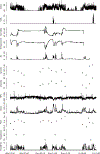Assessing the Exposome with External Measures: Commentary on the State of the Science and Research Recommendations
- PMID: 28384083
- PMCID: PMC7161939
- DOI: 10.1146/annurev-publhealth-082516-012802
Assessing the Exposome with External Measures: Commentary on the State of the Science and Research Recommendations
Abstract
The exposome comprises all environmental exposures that a person experiences from conception throughout the life course. Here we review the state of the science for assessing external exposures within the exposome. This article reviews (a) categories of exposures that can be assessed externally, (b) the current state of the science in external exposure assessment, (c) current tools available for external exposure assessment, and (d) priority research needs. We describe major scientific and technological advances that inform external assessment of the exposome, including geographic information systems; remote sensing; global positioning system and geolocation technologies; portable and personal sensing, including smartphone-based sensors and assessments; and self-reported questionnaire assessments, which increasingly rely on Internet-based platforms. We also discuss priority research needs related to methodological and technological improvement, data analysis and interpretation, data sharing, and other practical considerations, including improved assessment of exposure variability as well as exposure in multiple, critical life stages.
Keywords: exposome; external exposures; geographic information systems; global positioning systems; remote sensing; smartphones.
Figures









References
-
- Aceña J, Stampachiacchiere S, Pérez S, Barcelo D. 2015. Advances in liquid chromatography–high-high-resolution mass spectrometry for quantitative and qualitative environmental analysis. Anal. Bioanal. Chem 407(21):6289–99 - PubMed
-
- Álvarez-Romero JG, Devlin M, Teixeira da Silva E, Petus C, Ban NC, et al. 2013. A novel approach to model exposure of coastal-marine ecosystems to riverine flood plumes based on remote sensing techniques. J. Environ. Manag 119:194–207 - PubMed
-
- Austen K 2015. Pollution patrol. Nature 517:136–38 - PubMed

